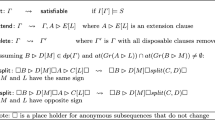Abstract
We present a sequent style proof system related to the MESON procedure, which is itself based on the model elimination strategy for mechanical theorem proving. The MESON procedure is attractive because it is a problem reduction format, that is, it has a goal-subgoal structure. The sequent style system based on it shares this advantage, and also has a simple declarative semantics and soundness proof. A refinement of the sequent style system tends to produce shorter sequents and may facilitate the use of the MESON procedure with caching of solutions to subgoals to avoid repeated work on the same subgoal. In the MESON procedure, a goal is marked ‘contradicted’ and considered to be solved, if an ancestor goal is complementary to it. In the positive refinement, only the positive goals need to be checked for contradiction in this way. This means that if a list of ancestor goals is kept with each goal, it is only necessary to store the negative ancestor goals, since these are the only ones that need to be examined in testing if a positive goal is contradicted. Similar restrictions on the reduction operation of model elimination are possible.
Similar content being viewed by others
Explore related subjects
Discover the latest articles, news and stories from top researchers in related subjects.References
Chang C. and Lee R., Symbolic Logic and Mechanical Theorem Proving, Academic Press, New York, 1973.
Clocksin W. F. and Mellish C. S., Programming in Prolog, Springer-Verlag, New York, 1981.
Gallier J., Logic for Computer Science: Foundations of Automatic Theorem Proving, Harper and Row, Philadelphia, 1986.
Loveland D. W., ‘A simplified format for the model elimination procedure’, JACM 16 (1969) 349–363.
Loveland D., Automated Theorem Proving: A Logical Basis, North-Holland, New York, 1978.
Loveland, D. W., ‘Near-Horn prolog’, Proceedings of the Fourth International Conference on Logic Programming, Melbourne, Australia, 1987, pp. 456–469.
Plaisted, D., Theorem Proving and Semantic Trees, Ph.D. thesis, Stanford University, 1976.
Plaisted D., ‘A simplified problem reduction format’, Artificial Intelligence 18 (1982) 227–261.
Plaisted D., ‘Non-Horn clause logic programming without contrapositives’, J. Automated Reasoning 4 (1988) 287–325.
Stickel M. E., ‘A PROLOG technology theorem prover: implementation by an extended PROLOG compiler’, J. Automated Reasoning 4 (1988) 353–380.
Author information
Authors and Affiliations
Additional information
This research was supported in part by the National Science Foundation under grant DCR-8516243.
Rights and permissions
About this article
Cite this article
Plaisted, D.A. A sequent-style model elimination strategy and a positive refinement. J Autom Reasoning 6, 389–402 (1990). https://doi.org/10.1007/BF00244355
Received:
Revised:
Issue Date:
DOI: https://doi.org/10.1007/BF00244355



